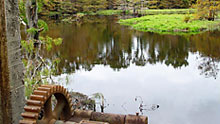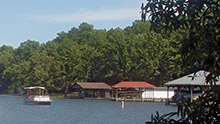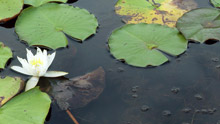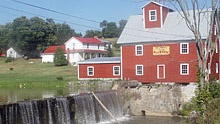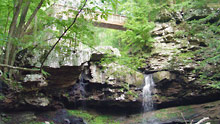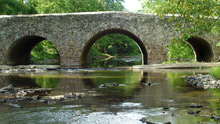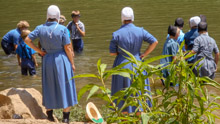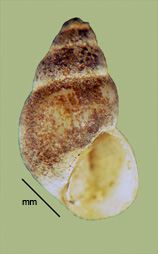Pyrgulopsis arga
> Habitat & Distribution
This was one of five new species described by Thompson in his (1977) monograph of the hydrobiid genus Marstonia. Its range was originally given as known only from the Tennessee River in the vicinity of the Guntersville Reservoir in northeastern Alabama and from Shoal Creek. We have, however, documented populations of M. arga further up the main Tennessee River into the lower reaches of the French Broad and Clinch, as well as in the major Cumberland River reservoirs: Old Hickory Lake, Dale Hollow Lake, and Lake Cordell Hull.
Thompson s observations suggested that M. arga preferred beds of the submerged macrophyte Najas, but generally not on Elodea or Myriophyllum. We have netted M. arga from beds of macrophytic vegetation representing all types, dead organic debris, and shallow soft shallow bottoms as well. On the margins of some reservoirs, populations seem to reach maximum density under stones.
We concur with Thompson s opinion that this species appears to be favored by the creation of large quiet bodies of water due to damming of the Tennessee River, and predict further increases in both the range and the population density of Marstonia arga in coming years. The species is non-apparently rare in our study area, FWGNA incidence rank I-3*.
> Ecology & Life History
Hydrobioids seem to be rather nonspecific grazers of small particles (Dillon 2000: 94-97). They are typically dioecious, the males being characterized by a penis that arises from the neck. Females attach single eggs in spare, hemispherical capsules to solid substrates (Hershler 1994). No specific life history data are as yet available for M. arga.
> Taxonomy & Systematics
Like Spilochlamys, Notogillia, and Floridobia, the genus Marstonia belongs to the subfamily Nymphophilinae of the Hydrobiidae (ss), males being characterized by a lobe-shaped penis (or verge) with surficial glandular patterns (Kabat and Hershler 1993, Hershler et al. 2003, Thompson 2004). The male reproductive system of M. arga was figured by Thompson (1977).
Baker (1926) originally proposed Marstonia as a subgenus of Amnicola. Thompson (1969, 1977) redefined and expanded the taxon, placing several newly-described southeastern species in it. Hershler and Thompson (1987) synonymized Marstonia under Pyrgulopsis on the basis of similarities in penial morphology. But after review of female reproductive anatomy, Thompson and Hershler (2002) resurrected Marstonia to generic status and allocated to it all eastern North American species previously placed in Pyrgulopsis. Female reproductive anatomy, specifically occurrence of a large extension of the albumen gland into the pallial roof, is a distinctly Marstonia characteristic (Hershler 1994, Hershler et al. 2003). Recent molecular-based phylogenetic analyses has also supported the distinction between Marstonia and Pyrgulopsis (Liu and Hershler 2005), and the retention of both genera in the Hydrobiidae sensu strictu (Wilke et al. 2013).
> Maps and Supplementary Resources
> Essays
- Earlier versions of this website, online until August of 2016, adopted the large, broadly-inclusive concept of the Hydrobiidae (sl) following Kabat & Hershler (1993). More recently the FWGNA project has shifted to the Wilke et al. (2013) classification system, distinguishing a much smaller Hydrobiidae (ss) and elevating many hydrobioid taxa previously ranked as subfamilies to the full family level. For more details, see The Classification of the Hydrobioids.
- Marstonia arga will make a guest appearance in my upcoming essay, "The SNTHICACBW Marstonia 6: pachyta. See the nice figure comparing M. arga to M. pachyta and two other hydrobioids of the lower Flint River.
> References
Baker, F.C. (1926)
Nomenclatural notes on American fresh water Mollusca. Transactions of
the Wisconsin Academy of Sciences, Arts, and Letters 22:193-205.
Dillon, R.T., Jr. (2000)
The Ecology of Freshwater Molluscs. Cambridge University Press,
Cambridge, United Kingdom.
Hershler, R. (1994)
A review of the North American freshwater snail genus Pyrgulopsis
(Hydrobiidae). Smithsonian Contributions to Zoology
554:1-115.
Hershler, R., H. Liu, and
F.G. Thompson (2003)
Phylogenetic relationships of North American nymphophiline gastropods
based on mitochondrial DNA sequences. Zoologica Scripta
32:357-366.
Hershler, R., and F.G.
Thompson (1987) North American Hydrobiidae
(Gastropoda: Rissoacea): redescription and systematic relationships of Tryonia Stimpson,
1865 and Pyrgulopsis
Call and Pilsbry, 1886. The Nautilus
101:25-32.
Kabat, A.R., and R.
Hershler (1993)
The prosobranch snail family Hydrobiidae (Gastropoda: Rissooidea):
review of classification and supraspecific taxa. Smithsonian
Contributions to Zoology 547:1-94.
Liu, H., and R. Hershler
(2005)
Molecular systematics and radiation of western North American
nympholine gastropods. Molecular Phylogenetics and Evolution
34:284-298.
Thompson, F.G. (1968)
The
Aquatic Snails of the Family Hydrobiidae of Peninsular Florida.
University of Florida Press, Gainesville, Florida,
USA.
Thompson, F.G. (1969)
Some hydrobiid snails from Georgia and Florida. Quarterly Journal of
the Florida Academy of Sciences 32:241-265.
Thompson, F.G. (1977)
The hydrobiid snail genus Marstonia.
Bulletin of the Florida State Museum 21(3):113-158.
Thompson, F.G. (2004)
An identification manual for the freshwater snails of
Florida.
Thompson, F. G. &
R. Hershler (2002) Two genera of North American
freshwater snails: Marstonia
Baker, 1926, resurrected to generic status, and Floridobia, new
genus (Prosobranchia: Hydrobiidae: Nymphophilinae). The
Veliger 45: 269 - 271.
Wilke T., Haase M., Hershler R.,
Liu H-P., Misof
B., Ponder W. (2013)
Pushing short DNA
fragments to the limit: Phylogenetic relationships of hydrobioid
gastropods
(Caenogastropoda: Rissooidea). Molecular
Phylogenetics and Evolution 66: 715 736.

